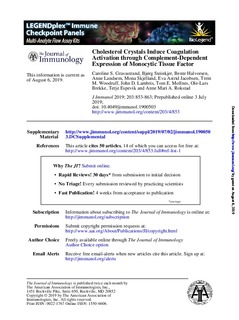Cholesterol Crystals Induce coagulation Activation through Complement-Dependent Expression of Monocytic Tissue Factor
Gravastrand, Caroline S.; Steinkjer, Bjørg; Halvorsen, Bente; Landsem, Anne; Skjelland, Mona; Jacobsen, Eva Astrid; Woodruff, Trent M.; Lambris, John D.; Mollnes, Tom Eirik; Brekke, Ole-Lars; Espevik, Terje; Rokstad, Anne Mari
Journal article, Peer reviewed
Published version
Permanent lenke
http://hdl.handle.net/11250/2607433Utgivelsesdato
2019Metadata
Vis full innførselSamlinger
Sammendrag
Cholesterol crystals (CC) are strong activators of complement and could potentially be involved in thromboinflammation through complement-coagulation cross-talk. To explore the coagulation-inducing potential of CC, we performed studies in lepirudin-based human whole blood and plasma models. In addition, immunohistological examinations of brain thrombi and vulnerable plaque material from patients with advanced carotid atherosclerosis were performed using polarization filter reflected light microscopy to identify CC. In whole blood, CC exposure induced a time- and concentration-dependent generation of prothrombin fragment 1+2 (PTF1.2), tissue factor (TF) mRNA synthesis, and monocyte TF expression. Blocking Abs against TF abolished CC-mediated coagulation, thus indicating involvement of the TF-dependent pathway. Blockade of FXII by corn trypsin inhibitor had a significant inhibitory effect on CC-induced PTF1.2 in platelet-free plasma, although the overall activation potential was low. CC exposure did not induce platelet aggregation, TF microparticle induction, or TF on granulocytes or eosinophils. Inhibition of complement C3 by CP40 (compstatin), C5 by eculizumab, or C5aR1 by PMX53 blocked CC-induced PTF1.2 by 90% and reduced TF+ monocytes from 18-20 to 1-2%. The physiologic relevance was supported by birefringent CC structures adjacent to monocytes (CD14), TF, and activated complement iC3b and C5b-9 in a human brain thrombus. Furthermore, monocyte influx and TF induction in close proximity to CC-rich regions with activated complement were found in a vulnerable plaque. In conclusion, CC could be active, releasable contributors to thrombosis by inducing monocyte TF secondary to complement C5aR1 signaling.
